Commonwealth Games - Glasgow 2014 ready to roll...
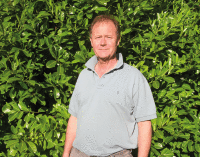
Give us a background on your appointment four years ago
The opportunity was advertised via Glasgow's City Procurement Portal in June 2010. Our Chairman had been involved in preparing the bowling greens for the 1980 Commonwealth Games in Edinburgh, but tendering for local amenity business has changed significantly in the interim. The Pre-Qualification Questionnaire (PQQ) itself ran to over one hundred questions, some of which required responses of up to 2,000 words, so we knew from the outset that the whole project would be scrutinised very thoroughly.
Twenty two construction companies applied initially, so we were extremely pleased to be short listed to three. Thereafter, we had to submit our price, together with a further quality submission. So, by the time we actually won the job, we had been living and breathing Kelvingrove for quite a time.
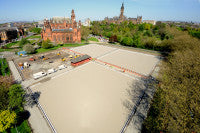
Kelvingrove Lawn Bowling Greens are, in effect, the manicured gardens of the iconic Kelvingrove Art Gallery & Museum which receives over a million tourist visitors a year and is the most popular museum in the UK outside London. Situated in the city's west end, on the edge of the campus of the University of Glasgow, it is a very well-known location on a main thoroughfare into Glasgow city centre.
Five of the six existing municipal bowling greens were to be redeveloped to meet the requirements of the Glasgow 2014 Commonwealth Games, with the sixth green remaining open to the public as long as possible. Reconstruction of the greens playing surfaces included new drainage, green ditches and installation of a new irrigation system, as well as the upgrading of the footpath network within the site to ensure compliance with the Disability Discrimination Act.
In legacy mode, the redeveloped bowling greens need to provide excellent facilities for hosting future international and national bowling events, as well as meeting the requirements of the existing bowling clubs based on the site and for public leisure use.
The contract for the supply and laying of the turf had already been awarded and was already growing off site in 2010 to ensure the turf would be available on completion of the greens construction.
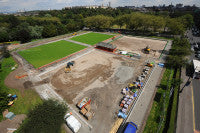
Mostly, everything has worked very well, although there are always occasions when you reach unchartered territory. I like to think that the scrutiny and checking that goes on prior to the job being awarded is to make sure that the client knows they are in capable hands if the project takes a detour. Thankfully, there were no major detours on this one.
For us, there were probably just two curve balls. The first was closing the busy arterial road, Kelvin Way, which separates greens numbered 1-4 with greens 5 and 6 for seven days. Never originally in the plan, this intervention took about a fortnight to go through planning and then another to be organised. Fortunately, at the time of implementation, the University of Glasgow's staff and students were on holiday. However, that meant what we lost in commuter traffic was made up with holiday visitors and coach parties in the vicinity.
The second was the challenge of the turf. When we came on board, the turf contract had been awarded elsewhere and had been in progress for several months grown on a site in Yorkshire. Turfing took place in the height of summer 2011. Logistically, we had twenty-four hours from when the turf was cut to having it in place. It left the turf farm early evening and then travelled 200 miles or so by road overnight for an early start the next morning. Naturally, it happened on one of the hottest days of summer, so we had to make sure it didn't get a chance to dry out. The irrigation system was used continuously during the installation and the weeks that followed, but all the planning paid off.
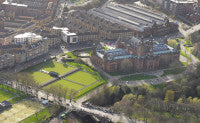
Our HQ is approximately five miles away and, as it is also the home of Wiedenmann UK and Fairways GM, dealer for Ransomes Jacobsen in Scotland, we've had access to demo machines and the benefit of training from their very experienced teams.
The biggest machine we've had out on the greens was a Wiedenmann Terra Spike Gxi8 HD deep tine aerator, which we started using in 2012 up until about six months ago. The new technology, balanced crankshaft, precise tine control and perfect weight distribution, makes this model the kindest ever to fine turf like the newly laid greens. We chose 12mm solid tines with a 50mm square hole pattern to depths of about 100-120mm. Fortunately, we have no issues with compaction so we've just used it to let water, air and nutrients access the roots. On each of the occasions, Wiedenmann's lead trainer in Scotland carried out the work as the spectacular backdrop of the Kelvingrove Art Galleries makes it a very coveted task in an unusual city location.
Another favourite has been the Smithco Tournament Ultra Greens Roller which is out fairly regularly and will be used even more in the run up to the event.

We've used a pedestrian Mete-R-Matic topdresser, and have recently purchased a Protea pedestrian verticutter to ensure the greens' pace is faster than ever.
Has the recent wet weather hindered the development?
The recent wet weather hasn't affected the greens much, but several freakish weather windows in the last four years for the west of Scotland certainly made us react.
Right at the start of the project, in November 2010 when we had been on site just about a week, our first major task was to dig up and remove the five original worn greens. Removal had started well but, about forty-eight hours in, the weather changed and an unprecedented ten weeks of intensely cold and snowy conditions began, stretching late into January 2011, with temperatures below -10°C not unusual.
Fortunately, we were in the process of recycling topsoil to other Glasgow City Council golf clubs, so the bulk of the transportation had happened already.
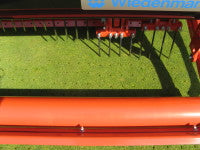
Then, summer 2013 brought an unmatched dry spell with almost unbroken sunshine from 3rd-23rd July toppling local records and truly testing our irrigation system in a way we never imagined.
However, one good thing about those recent months of incessant rain is that we know our drainage is tip top. Whatever amount falls and whatever amount lies on the surface, once the rain ceases the drainage on the new greens clears all residual water in roughly fifteen minutes. We've been monitoring this closely and it is true every time.
What has your relationship been like with the greens staff?
We are the greens staff, and this was always one of the attractive aspects of winning the bid. Fairways Sportsgrounds is officially contracted to employ an experienced, full time greenkeeper to manage the site. Initially, we took on greenkeeper Neil Plenderleith, who oversaw the greens for the first eighteen months and nursed them along until June 2012 when he handed them on to Craig Collins. Craig (28) had previously trained at Whitecraigs Golf Club in Glasgow and then had several years experience in the US, so was ready for the challenge on his return.

Regular elite training squad sessions take place on a fortnightly basis and several international standard events have been staged by way of testing the facilities. A four way international match was held last June, followed by an eight way competition run in September. Both were organised by Bowls Scotland and these were enormously helpful for feedback, testing equipment and determining whether we had considered how the bowlers would be accommodated in a busy situation.
Ten separate events are scheduled for the Commonwealth Games, which include two for bowlers who are visually impaired or have a physical disability. The September international had a para sports competition integrated into the lawn bowls programme, which again helped us make sure we were fully set up to meet everyone's requirements.
In recent months, the Bowling Centre has attracted quite a lot of media activity for the likes of Mercedes and Irn Bru. Craig's role has also been highlighted by the Games' own PR team and we tease him that he might yet become the poster boy of the Commonwealth Games.
Others in the Fairways Sportsgrounds' team will become increasingly involved as the weeks tick by.
Will you be on hand during the Games to offer assistance?
Yes, absolutely. Already, there are firm plans in place for the bowling green events which start on 24th July and conclude on 1st August. There are a couple of Committees looking after all the arrangements and we are in constant touch with their representatives. Logistically, there's a lot to do, but our focus is quite unequivocally to present the greens to the best of our ability.

Each entrant into the bowling events is scheduled practise time on the actual surface so, once play starts in the morning, the greens are in use virtually until darkness falls, so those early daylight hours will be incredibly important. However, it's not hugely different from a major golf or tennis venue hosting an event.
We've got spare mowers and parts on standby and hope that we get a mixed bag of weather rather than either of the extremes.
Describe, if applicable yet, handover comments/feedback from the centre and governing bodies such as World Bowls and Glasgow City Council
At the end of the first year of the project Kerry Clark, World Bowls Technical Delegate for Glasgow 2014 and World Bowls Chief Executive Gary Smith came to Glasgow to meet the Organising Committee and assess the greens just after they were laid. At the time, Gary Smith, World Bowls Chief Executive said; "It's been fantastic to see first-hand the level of preparation and work that's gone into the greens already, which is a credit to the Organising Committee and its Games Partners."
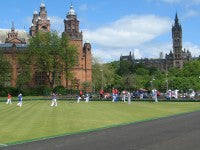
Greg Warnecke, Head of Sport at Glasgow 2014 said; "Visits involving our International Federation representatives are an important part of our on-going planning. It offers us an opportunity to develop our relationship with sport governing bodies and instil a level of confidence in our preparations for 2014."
"We are delighted to receive such positive endorsement and it's extremely pleasing to receive this kind of feedback."
David Gourlay, Head Coach Bowls Scotland commented; "The greens at Kelvingrove are in excellent condition; they are particularly smooth and flat and are well on track for providing a world class playing surface come July."
What renovation work will be carried out after the games to get the greens and the venue ready for the next season?
Tiered seating for about 2,500 is readily removed, so it will be relatively quick to return the facility back to normal. Immediately after the Games, we will rest the greens for a week to try to let them recover. They will have been cut to a height of 3mm every day of the previous fortnight and in play for at least twelve hours a day, so we will fertilise them straight away and let them grow back without any rush to mow them urgently. After that there's a plan to verticut, topdress, then hollow core and then leave them to further rest and let the grass grow.

Many people are surprised to learn that all six of the bowling greens are in play by the public on a daily basis, even now before the Games have started. Potentially, there can be 144 members of the public playing, as there are four players to a rink and six rinks to a green.
However, this assumes that many of them bring their own bowls as we don't have that number of full sets of bowls on site!
Craig Collins rotates the rinks from north to south and from east to west, careful to alternate the direction of play. Everything is supervised by Glasgow Life staff who actively check that flat shoes are worn at all times.
Already there are some international fixtures in the 2015 calendar with Kelvingrove as venue, so there is a requirement to keep the greens in pristine condition.

